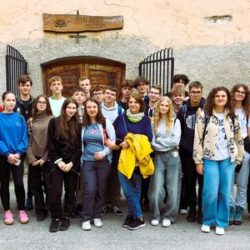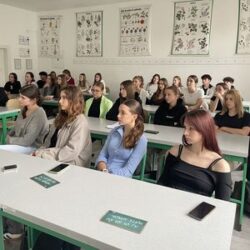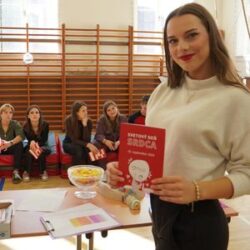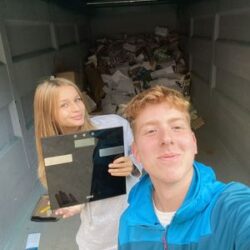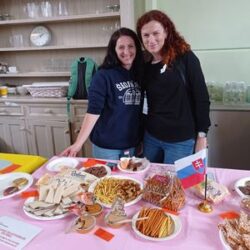Erasmus+: návšteva z českého gymnázia
aktivita: Erasmus
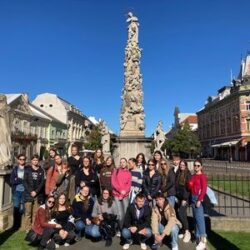
sme na železničnej stanici privítali nenápadnú, ale veselú skupinku z českého Gymnázia Františka Palackého v Neratoviciach. Keď sme tých istých ľudí odprevádzali po týždni na vlak do Prahy, objímali sme sa a lúčili s priateľmi. Týždeň utiekol rýchlo, ale vzťahy, ktoré počas neho vznikli, určite vydržia dlhšie. Napokon vzájomné vzťahy a to, čo nás spája, teda spoločná história, umenie a literatúra, boli aj témou nášho Erasmu.
Hneď v pondelok si naši žiaci pripravili kvízy a úlohy zamerané na podobnosti a odlišnosti nášho jazyka. Spoločne sme aj vytvárali cinquain a tvorili „pražácko-východňarsky“ slovník. Utorok sme venovali tomu, aby sme návšteve ukázali Košice. Výhľad z Chrámu sv. Alžbety či podzemie mesta dotvorili obraz o tom, aké krásne mesto plné histórie máme. Vo Východoslovenskom múzeu sme si prostredníctvom interaktívnej výstavy o gotike a baroku zopakovali aj vedomosti z literatúry a umenia. Na stredu bol naplánovaný výlet do Vysokých Tatier. Počasie sme ovplyvniť nedokázali, ale dobrá nálada a chuť spoznávať spôsobili, že aj napriek upršanému a chladnému počasiu sme si túru na Popradské pleso užili. Nasledujúci deň patril opäť kultúre a literatúre. Na vzácne zbierky a zaujímavý výklad o uchovávaní starých kníh sme sa boli pozrieť v Lyceálnej knižnici v Kežmarku. Návštevou Dreveného artikulárneho kostola aj Nového evanjelického kostola sme dotvorili predstavu o dejinách východného Slovenska. V piatok sme sa boli pozrieť na literatúru z inej strany. V Múzeu obetí komunizmu v Košiciach sme sa dozvedeli aj o temnejších dejinách našej kultúry, o tom, ako sa písali a šírili samizdaty. Piatkový večer napokon patril imatrikulačnému plesu našich prvákov a našim českým priateľom sme tak ukázali, aká je tá naša Šrobárka — akčná, kreatívna, plná nápadov a skvelých akcií.
It was on September 28 when we welcomed a modest but cheerful group from the František Palacký Grammar School in Neratovice, Czech Republic at the train station. When we were seeing the same people off to catch the train to Prague a week later, we hugged and said goodbye to a group of friends. The week passed quickly, but the relationships that were formed during it will surely last longer. After all, mutual relationships and the things that connect us—our shared history, art, and literature—were the focus of our Erasmus project.
Right on Monday our students prepared quizzes and tasks focused on the similarities and differences in our languages. Together we also created cinquains and compiled a „Pražácko-Východňarsky“ (Prague-Eastern dialect) dictionary. On Tuesday we dedicated the day to showing our guests around Košice. The view from St. Elizabeth’s Cathedral and the underground part of the city completed the picture of what a beautiful, history-filled city we have. In the East Slovak Museum we revisited our knowledge of literature and art through an interactive exhibition on Gothic and Baroque styles.
Wednesday’s plan was a trip to the High Tatras. Although we couldn’t control the weather, the good mood and eagerness to explore meant that, despite the rainy and cold conditions, we enjoyed our hike to Popradské Pleso. The next day was once again dedicated to culture and literature. We visited the Lyceum Library in Kežmarok to see rare collections and hear an interesting lecture on the preservation of old books. Our visit to the Wooden Articular Church and the New Evangelical Church further enriched our understanding of the history of eastern Slovakia.
On Friday we took a different approach to literature. At the Museum of Victims of Communism in Košice we learned about the darker aspects of our culture’s history, including how samizdat literature was written and circulated. Friday evening concluded with the initiation ball for our first-year students, where we showed our Czech friends what Šrobárka is all about—action, creativity, full of ideas, and amazing events.


